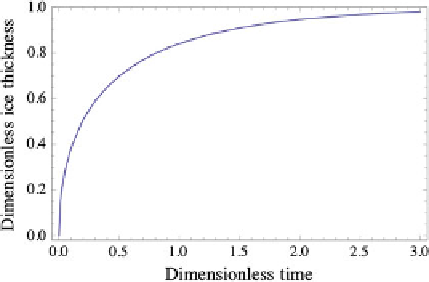Geoscience Reference
In-Depth Information
The heat
fl
flux from the water, Q
w
, can be added to the Stefan
'
s model (Eq.
4.37
)as
dt
þ
Q
w
¼ k
T
f
T
0
q
L
f
dh
ð
4
:
45
Þ
h
flux from the water need to
be conducted away through the ice. Both sides of this equation are nonnegative so that
melting of ice is also allowed and takes place when the heat
Thus both the latent heat released in freezing and the heat
fl
fl
flux from water is larger than
the heat conduction through the ice.
Assume that the surface temperature and the heat
fl
flux from water are constants. Then
there is an equilibrium solution with dh/dt =0:
h
e
¼ k
T
f
T
0
Q
w
ð
4
:
46
Þ
flux received from water is conducted through the ice to the atmo-
sphere. Furthermore, with T
0
and Q
w
constants, Eq. (
4.45
) can be solved analytically in an
implicit form for h = h(t):
Exactly the heat
fl
¼
s
; s
¼
2
a
2
T
f
T
0
h
h
e
þ
1
h
h
e
q
w
Lh
e
Q
w
¼
1
log
ð
4
:
47
Þ
2
½
Q
w
=ðq
w
L
Þ
where
is the time-scale of the system. The solution is illustrated in dimensionless form in
Fig.
4.10
. E.g., for T
f
−
˄
C and Q
w
=5Wm
−
2
, we have h
e
= 40 cm and
= 281 d.
If the situation remains for, say, for 50 days, the solution is valid only to the time t/
˄
T
0
=10
°
˄
˄
= 0.18. If the heat
fl
flux from the water is doubled, we have h
e
= 20 cm and
=70d.In
(h/h
e
)
2
and the ice grows
proportional to the square root of time. The thickness
½
h
e
is reached at the time t = 0.19
·
˄
= 13 days.
In the Stefan
the beginning (h
≪
h
e
), the left side is approximately
−½
is law, when the surface temperature is below the freezing point the ice
grows without limit but any heat
'
fl
flux from the water body brings the asymptote h
e
to the
Fig. 4.9
Dimensionless ice
thickness h/h
e
as a function of
dimensionless time in the
presence of heat flux from the
water body; ice thickness is
scaled by the asymptotic
equilibrium thickness h
e
, and
time is scaled by the rate of
melting
ˁ
w
Lh
e
/Q
w








Search WWH ::

Custom Search